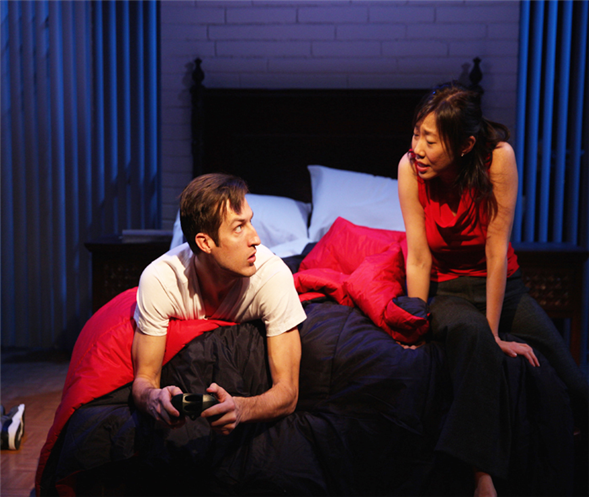When time and music work differently on stage, pay attention. That may be the key to understanding an entire show.
At least, that's how it feels with Long Story Short, a musical that condenses 50 years of a couple's relationship into 90 minutes. In the opening scene, a young woman named Hope is on a first date with a guy named Charles, and just a few heartbeats later, they're living together. Soon enough, they have a child, launch new careers, and weather a personal tragedy.
Yet for all the time it covers, the show doesn't cram every birthday and argument onto the stage. Adapting the piece from David Schulner's play An Infinite Ache, writer-composers Brendan Milburn and Valerie Vigoda linger on certain events, filling them with details about how Hope and Charles come together and sometimes drift apart. When time jumps forward, it's like we're flowing to the next vital moment in their lives, seeing the days or weeks that most define their ability to love each other.
The music is just as fluid. A traditional musical might halt the action for a song-and-dance extravaganza, but in Long Story Short, which is now at 59E59 in a production from Prospect Theater Company, the songs often emerge in the middle of a scene, gurgling up mid-speech to support an intense emotion. Most of the time, there isn't even a pause at the end of a number. Instead, the actors just immediately start talking after they finish singing, letting the story carry on.
For Pearl Sun, who plays Hope, it's crucial that the music works this way. "It feeds the structure of the piece itself," she says. "Because time doesn't stop in this piece. Years and moments just flow one to the next, so why would the musical numbers just stop? Having a button on a musical number would make it more jagged. It would stop time, and the whole point of the story is that time never stops."
"Even the one or two times when we <em>do</em> have a button after a song, it's because time is shifting again," she adds. "Everything is connected to the way the story works."
{Image2}
To fully integrate the songs into the characters' lives, musical director Vadim Feichtner has Sun and her co-star Bryce Ryness speak-sing sections of their numbers. Full-out singing is reserved only for the most potent scenes. "That gives me the freedom to dig deeply into the lyrics and focus on what I'm saying versus how I'm sounding," Sun says.
Plus, when the characters are younger, Feichtner sets their songs in higher keys, then lowers them as they age. "If you're singing higher, it requires more breath support and more energy, and that feeds the youthful physicality," Sun explains. "And as I progress, the lower tones give a richness that, to me, suggests feeling more settled in one's self."
For Sun, who also played Hope when Long Story Short premiered in California in 2008, any clue about her character's personality is useful. After all, she has to craft a woman's entire, complicated life, from high points to low.
"The audience needs to be equally charmed and put off by [Hope and Charles]," she says. "Because these are imperfect people, as all of us are. And that's what I find beautiful about this piece. It doesn't exalt love or look at it through rose-colored glasses. They go through tough, sometimes terrible things, and the piece knows that love can be challenging and difficult and dirty. But there's beauty in being able to find someone to go through the muck with."
---
Mark Blankenship is the editor of TDF Stages
Photo by Matthew Murphy
